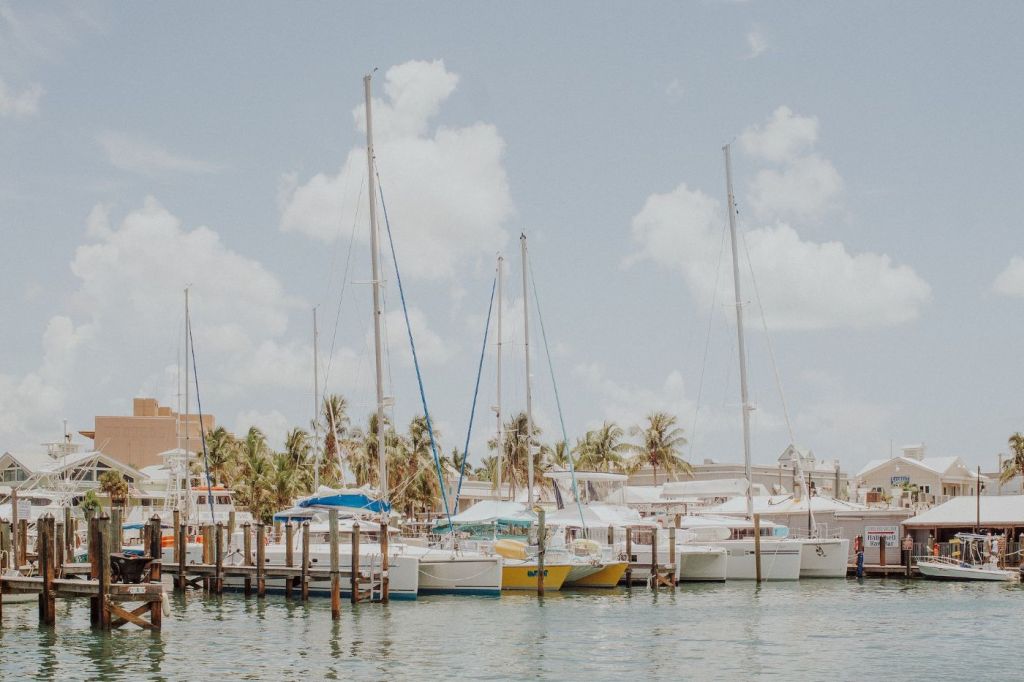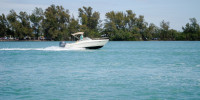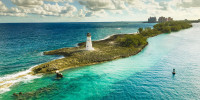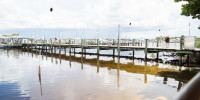Overview of Florida's No Discharge Zones
In Florida, there are areas that strictly prohibit sewage discharge from vessels, and you should be aware of them to avoid fines and protect the environment. Most areas that prohibit discharge are those with high vessel traffic, have sensitive ecological systems, and where recreational activities such as swimming, fishing, and boating are conducted. In this article, we'll give you an overview of Florida's No Discharge Zones and a list of places in Florida that rule out this law.
A No Discharge Zone (NDZ) is an area of water where the discharge of sewage and other liquid wastes from all boats is prohibited. Florida has designated NDZs to protect the environment and public health. Here, boaters must either use pump-out facilities or hold their sewage until they reach an area outside the NDZ.
One of the most well-known NDZs in Florida is the Florida Keys National Marine Sanctuary. This area was designated an NDZ in 2002 and covers state waters within the sanctuary. Let's take a look at other areas designated as NDZs in Florida.
Summary
- No Discharge Zones are designated by the state and approved by the EPA under Section 303(d) of the Clean Water Act.
- One benefit of NDZs is that they help protect water quality by reducing the amount of sewage discharged into the water.
- NDZs are commonly established in areas with sensitive ecological systems, such as coral reefs, seagrass beds, and other marine habitats.
- NDZs help to protect recreational resources by ensuring that the water is safe for people to use and enjoy.
- The Suwannee River is one of the rivers in Florida that is protected by NDZ since it is home to several endangered species, including the Gulf sturgeon and the Suwannee moccasin shell mussel.

On this page:
No Discharge Zones in Florida
According to the United States Environmental Protection Agency (EPA), a No Discharge Zone is "an area of water where the discharge of sewage and other liquid wastes from all vessels is prohibited." The purpose of NDZs is to protect water quality and public health by reducing the amount of sewage discharged into the water.
In Florida, NDZs are designated by the state and approved by the EPA under Section 303(d) of the Clean Water Act. This section requires states to identify impaired waters and develop Total Maximum Daily Loads (TMDLs) for those waters. If a state designates an NDZ as part of its TMDL, the EPA can approve that designation.
The state may create NDZs in areas where there is a need for greater environmental protection and where adequate pump-out facilities are available. The state may also completely prohibit sewage discharge from vessels, whether the sewage is treated or not, into some or all of its waters.
If you're curious as to how marine toilet works, this article has a detailed discussion of the different types of marine toilets.
The Florida Department of Environmental Protection (FDEP) is responsible for enforcing the NDZ regulations. The FDEP works in collaboration with the U.S. Coast Guard to ensure that boaters comply with the regulations. The FDEP also provides information to boaters and marina operators on the NDZ regulations and compliance requirements.
Benefits of No Discharge Zones
No Discharge Zones offer several benefits, including the following:
Protecting water quality
NDZs help protect water quality by reducing the amount of sewage discharged into the water. Sewage contains harmful pollutants, such as bacteria, viruses, and nutrients, which can degrade water quality and harm aquatic ecosystems.
By prohibiting boats from discharging sewage in NDZs, the water quality is maintained and pollution is prevented.
Improving public health
NDZs improve public health by preventing the spread of diseases that can be transmitted through contact with sewage. Hepatitis A and E are examples of diseases that can be transmitted through contact with contaminated water.
By establishing NDZs, the risk of exposure to these diseases is reduced, and public health is improved.
Supporting marine life
NDZs support marine life by reducing harmful nutrients and bacteria in the water. Nutrient pollution, such as excess nitrogen and phosphorus, can cause harmful algal blooms and lead to oxygen depletion in the water.
This can harm fish and other aquatic organisms. By reducing the amount of nutrients and bacteria in the water, NDZs help promote a healthy marine ecosystem.
Encouraging pump-out facilities
NDZs encourage the use of pump-out facilities, which can help prevent accidental spills and overflows of sewage. Pump-out facilities are designed to safely remove and dispose of sewage from boats.
By promoting the use of these facilities, NDZs help prevent accidental spills and overflows, which can harm the environment and public health. If you're looking for a cheap boat dock in Florida with pump-out stations as added amenities, you might find this article helpful.
Common Areas Where NDZs Are Established
NDZs are established in areas where the discharge of treated or untreated sewage from vessels or floating structures could harm water quality, aquatic life, or human health. NDZs are typically established in the following areas:
In areas with high vessel traffic
NDZs are often established in areas with high vessel traffic because the discharge of sewage from boats can have a significant impact on water quality and public health. In these areas, there is a greater risk of sewage discharge, which can lead to the contamination of waterways and the spread of waterborne diseases.
In areas with sensitive ecological systems
NDZs are also established in areas with sensitive ecological systems, such as coral reefs, seagrass beds, and other marine habitats. These ecosystems are often fragile and can be easily damaged by the discharge of sewage from boats. NDZs help to protect these ecosystems by preventing the discharge of sewage and reducing the risk of damage.
In areas with recreational activities on the water
NDZs are often established in areas that are used for recreational activities such as swimming, fishing, and boating. These activities are popular in many coastal areas and can be impacted by the discharge of sewage from boats. NDZs help to protect these recreational resources by ensuring that the water is safe for people to use and enjoy.
List Of NDZs In Florida
Florida has several NDZs located in its waters, including the following:
| NDZ name | Year established | Coverage area |
|---|---|---|
| Tampa Bay NDZ | 1996 | Hillsborough, Pinellas, and Manatee counties |
| Pinellas County NDZ | 2002 | Pinellas County |
| Site One NDZ | 2001 | Parts of Biscayne Bay, the Miami River, and the Intracoastal Waterway |
| Aquatic Preserves NDZ | N/A | Charlotte Harbor Preserve State Park, Estero Bay Preserve State Park, Lemon Bay Preserve State Park, and Rookery Bay Preserve State Park |
| Lakes and Rivers NDZ | N/A | Lake Okeechobee, St. Johns River, and Suwannee River |
No Discharge Zone in Tampa Bay
The Tampa Bay NDZ was established in 1996 and it covers the entire Tampa Bay area, including Hillsborough, Pinellas, and Manatee counties. It includes all waters within the bay, including the Hillsborough River, the Alafia River, and the Little Manatee River.
Tampa Bay was chosen as an NDZ because it is a large and ecologically important body of water that is home to a diverse array of plant and animal species.
It is also a popular destination for recreational boating and fishing, and the discharge of sewage from vessels can have a significant impact on water quality and the health of the ecosystem. Yacht rentals in Tampa only cost around $634 per hour for small yachts to up to $1,000 per hour or more for larger, more luxurious yachts.
Additionally, the Tampa Bay area has experienced significant population growth and urbanization in recent decades, which has increased the amount of pollution entering the bay. Establishing an NDZ in Tampa Bay was seen as an important step in protecting the health of the bay and preserving its ecological and economic value for future generations.
No Discharge Zone in Pinellas County
Established in 2002, the Pinellas County NDZ covers all waters within the county, including the Intracoastal Waterway, Clearwater Harbor, and Boca Ciega Bay.
The decision to designate Pinellas County as an NDZ was based on several factors, including concerns about water quality, public health, and the impact of vessel sewage discharge on sensitive marine ecosystems. Pinellas County is home to a number of popular beaches and boating destinations, and the EPA recognized the need to protect these areas from the harmful effects of sewage discharge.
By designating Pinellas County as an NDZ, the EPA is helping to ensure that the water in and around Pinellas County remains clean and healthy for both people and wildlife.
No Discharge Zone in Site One
Established in 2001, Site One NDZ covers all waters within the Site One area, which includes parts of Biscayne Bay, the Miami River, and the Intracoastal Waterway.
The Site One NDZ was established to protect the waters within the Site One area from pollution caused by vessel sewage discharge. Under the NDZ regulations, vessels are prohibited from discharging any sewage, whether treated or untreated, into the waters within the Site One area. This means that all vessels must have a holding tank or other approved sewage treatment system on board to prevent any sewage from being discharged into the water.
The establishment of the Site One NDZ has helped to improve the water quality in the area and protect the marine environment. It is part of a larger effort to create NDZs throughout the United States, with the goal of reducing pollution and protecting public health.
No Discharge Zone in aquatic preserves in Florida
Florida has several aquatic preserves that are designated as NDZs including the Charlotte Harbor Preserve State Park, the Estero Bay Preserve State Park, the Lemon Bay Preserve State Park, and the Rookery Bay Preserve State Park.
The aquatic preserves in Florida that are designated as No Discharge Zones (NDZs) were chosen due to their ecological significance and the importance of protecting the waters within them from pollution caused by vessel sewage discharge.
Aquatic preserves are areas that are designated to protect and preserve the natural and cultural resources of Florida's aquatic environments. These areas are home to a diverse array of marine life, including fish, birds, sea turtles, and manatees. They are also important for recreational activities such as fishing, boating, and swimming.
The establishment of NDZs within aquatic preserves helps to protect the water quality and ecological health of these areas by preventing the discharge of sewage from vessels. This is particularly important in areas where there is a high concentration of boats and other watercraft, as well as areas that are vulnerable to pollution from other sources, such as stormwater runoff.
No Discharge Zone in lakes and rivers in Florida
Florida has several lakes and rivers that are designated as NDZs, including Lake Okeechobee, the St. Johns River, and the Suwannee River.
The lakes and rivers in Florida that are designated as No Discharge Zones (NDZs) were selected based on their ecological importance and sensitivity, as well as their popularity for recreational activities such as boating, fishing, and swimming.
- Lake Okeechobee is the largest freshwater lake in Florida and an important source of drinking water for millions of people.
- St. Johns River is a major waterway that flows through several counties in central Florida and supports a diverse range of aquatic species.
- Suwannee River is a popular destination for boaters and anglers and is home to several endangered species, including the Gulf sturgeon and the Suwannee moccasin shell mussel.
Did you find the answer to your specific question?
👍 0 👎 1




Leave a comment